Works Stage Ze Quiet Place (1983)
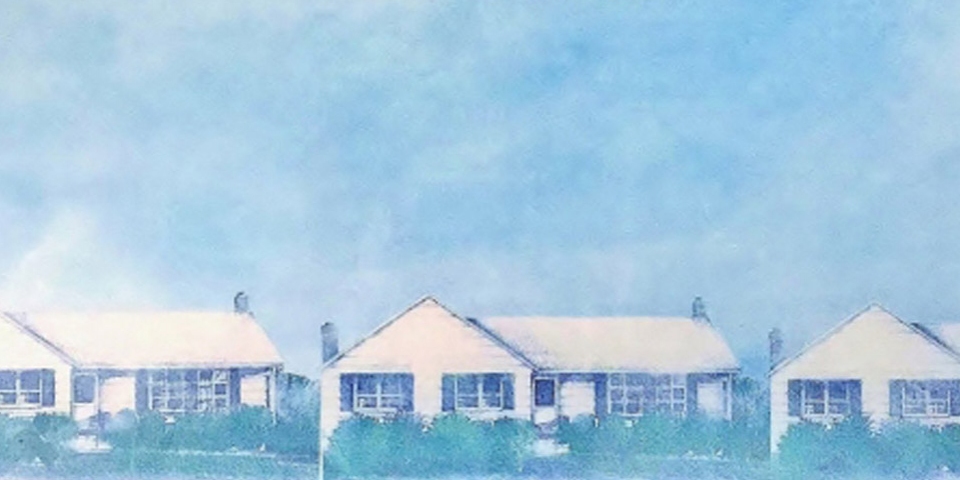
A Quiet Place
by Leonard Bernstein and Stephen Wadsworth
Leonard Bernstein’s final work for the stage, A Quiet Place finds a fractured family struggling to come to grips with its past, and to reconcile, in the aftermath of a tragic event. One of the greatest American operas, A Quiet Place exists in two performable versions: the 1986 version and the 2013 adaptation.
1986 Version (link to new page)
The Authors’ definitive version of the opera, the 1986 version incorporates Bernstein’s final thoughts on the work. This grand-scaled version features a larger cast, full chorus and large orchestra. The second act incorporates the entirety of Bernstein's 1951 opera, Trouble in Tahiti, as a flashback.
2013 Adaptation (link to new page)
This adaptation, by Garth Edwin Sunderland, provides a more intimate, naturalistic experience of this very personal work. With fewer singers, a smaller orchestration, and a shorter running time, this version is performable by smaller forces, with a larger orchestration available for bigger houses. This version does not include Trouble in Tahiti, and includes three arias not included in the 1984 version.
Background
A Quiet Place gives you the ability to make you feel the emotions Leonard Bernstein had when he was writing an, at times, painfully personal opera...it is also a piece of subtlety and suggestion, a short story with the weight of a novel, an example of masterly craft and postmodern style. -The New York Times
When comparing Leonard Bernstein's two operas, Trouble in Tahiti (1951) and its sequel, A Quiet Place (1983; rev. 1984), one can reflect on the vast changes in the American cultural landscape between the 1950s and the 1980s. Trouble in Tahiti was Bernstein's satirical caricature of 1950s American suburban life, gently exposing the illusion of contentment through its candid depiction of a couple's failing marriage; however, A Quiet Place examines the same family, three decades later, through a darker and more emotionally wrought lens. What was satirical, melodic, and jazz-inflected in the earlier chamber-opera became deeply psychological and percussive, moving fluidly between tonality and atonality.
A Quiet Place tells the story of a contemporary American family struggling to connect, forgive, and accept one another's differences after the death of a loved one. They all yearn for and remember moments of intimacy, but struggle desperately to achieve it in the present. This is presented musically by repurposing musical and dramatic motifs from Trouble in Tahiti, and though often dark and emotionally searing, A Quiet Place is interspersed with moments of communion, and ultimately ends on a hopeful note with a promise of reconciliation.
In 1980, Bernstein discovered that a 30-year-old writer named Stephen Wadsworth had a similar idea of writing a sequel-opera to Trouble in Tahiti, so they began working together to achieve their common goals. On a personal level, they felt a need to write about death and loss; Bernstein's wife Felicia had died of cancer two years earlier, and Wadsworth's sister Nina had been killed in a tragic car accident only one year before. Artistically, they wanted to write an "American" opera—a through-sung musical drama that would use vernacular speech and music to explore American middle-class problems by drawing upon the American musical theater tradition in addition to contemporary opera.
A triple commission from Houston Grand Opera, the Kennedy Center, and La Scala, A Quiet Place premiered in Houston on June 17, 1983, as a two-hour, one-act opera that followed Trouble in Tahiti on a double bill. The reviews were mixed and extreme. Some critics rejected the unusual subject matter and hybrid form, while others lauded the work for its musical sophistication and inventiveness. After the premiere, conductor John Mauceri urged the writers to re-conceive the relationship between the two works, and in the year that followed, Bernstein and Wadsworth trimmed parts of the original A Quiet Place and interpolated the 40-minute Trouble in Tahiti into the new work as two flashback scenes.
The 1984 revised version—now a three-act opera containing all of Trouble in Tahiti—creates a more immediate dialog between past and present, the original musical motifs, and their reprises. The revised A Quiet Place premiered at La Scala in June 1984, conducted by Mauceri and directed by Wadsworth. The production was very well-received in Italy before moving to the Kennedy Center the following month, and the opera was subsequently performed in Austria, Germany and the Netherlands.
It may be that A Quiet Place was simply ahead of its time. As Bernstein said of his only full-length opera and final stage work, "It sounds like no other work by me or by anybody else I know of . . . It has a special language and sound all its own. The American language has never been treated in this particular way before." However, much has changed in American opera since 1984. Crossover works that blend a variety of musical styles and explore contemporary subject matter are now much more common. In this new environment, A Quiet Place finally enjoyed its New York Premiere in 2010 with the New York City Opera's production, directed by Christopher Alden and conducted by Jayce Ogren, and continues to intrigue audiences through its musical and psychological complexities.
Throughout the Leonard Bernstein Centennial, A Quiet Place received 40 performances by opera companies in Austria, Germany, Hungary, the Netherlands, and the US.
Related Works
Trouble in Tahiti
Related Content
US Opera – A Quiet Place
Details
Orchestral Suite from A Quiet Place
(arr. 1991) 25 min.
arranged for orchestra by Sid Ramin and Michael Tilson Thomas with assistance of Michael Barrett
- Scoring: 3(II=afl,III=picc).2.corA. 3(III=Ebcl).bcl.asax.2.dbn - 4.3.3.1 - timp.perc(5-6) - elec.keyboard - harp-strings
- World Premiere: September 19, 1991 | Barbican Centre, London, United Kingdom | London Symphony Orchestra / Michael Tilson Thomas, conductor
To perform A Quiet Place, please contact the theatrical agent, Boosey & Hawkes. For general licensing inquiries, please click here.
To purchase A Quiet Place, please visit our store.
Media
World Premiere Poster
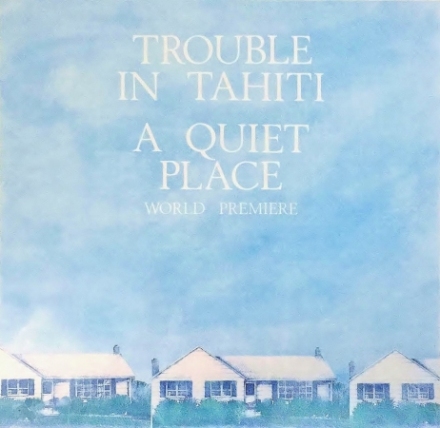
Houston Grand Opera, 1983
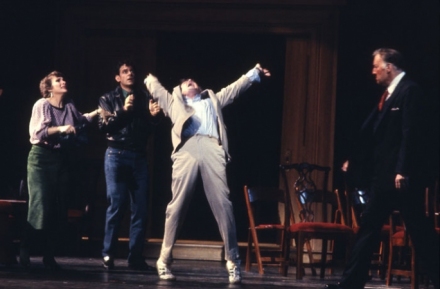 © HGO, 1983
© HGO, 1983
Houston Grand Opera, 1983
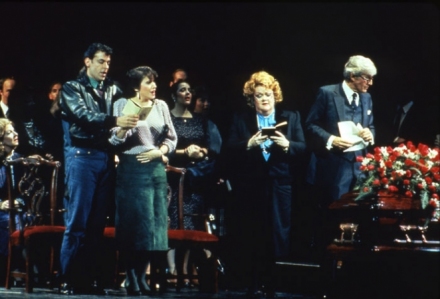 © HGO, 1983
© HGO, 1983
Bernstein rehearsing his opera A Quiet Place in Houston, photo dated 3/7/83
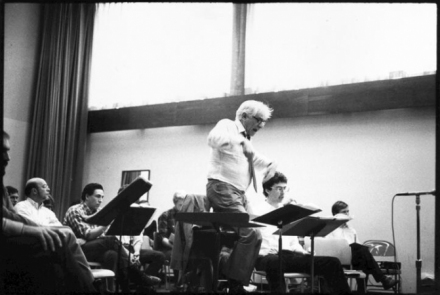 Library of Congress Music Division Digital Archives
Library of Congress Music Division Digital Archives
A Quiet Place, Scene 3 manuscript sketch
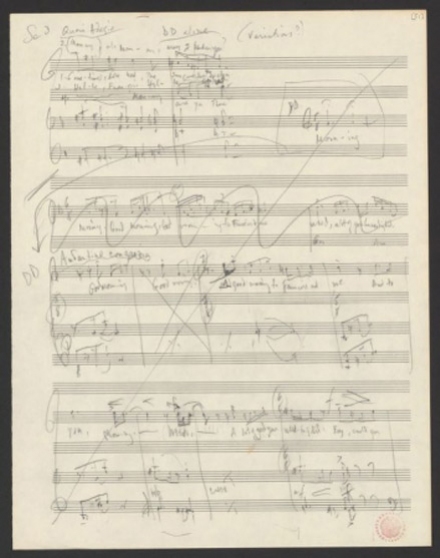 Library of Congress Digital Archives
Library of Congress Digital Archives
LB conducts the Prelude
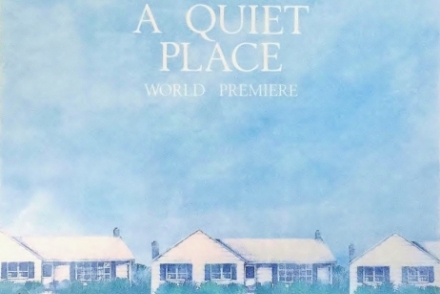 Bernstein: A Quiet Place - "The One and Only Cereal" / Bernstein • ORF Symphonie Orchester
Bernstein: A Quiet Place - "The One and Only Cereal" / Bernstein • ORF Symphonie Orchester
Review A Family’s Misery, a Composer’s Moment From "The New York Times | Anthony Tommasini" 2010 Review Classical CD Review: A Superb Version of Leonard Bernstein’s “A Quiet Place” From "The Arts Fuse | Jonathan Blumhofer" 2018 Review A Quiet Place at the end of Leonard Bernstein's life From "The Cultural Critic | Steve Cohen" 2018